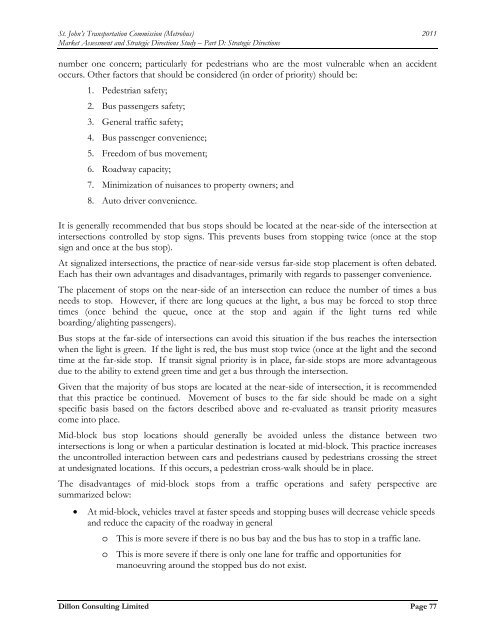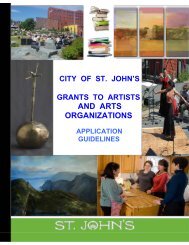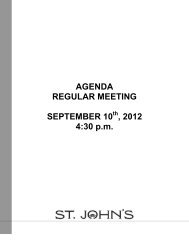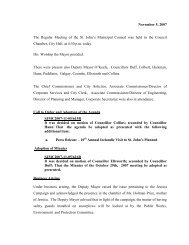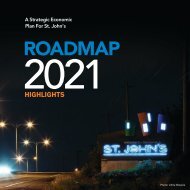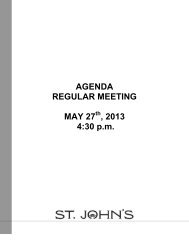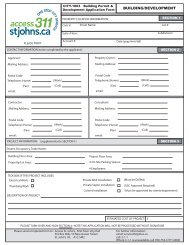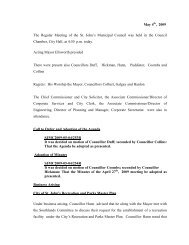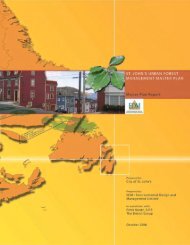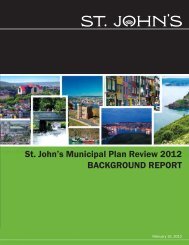Metrobus Transit Study.pdf - City of St. John's
Metrobus Transit Study.pdf - City of St. John's
Metrobus Transit Study.pdf - City of St. John's
Create successful ePaper yourself
Turn your PDF publications into a flip-book with our unique Google optimized e-Paper software.
<strong>St</strong>. John’s Transportation Commission (<strong>Metrobus</strong>) 2011<br />
Market Assessment and <strong>St</strong>rategic Directions <strong><strong>St</strong>udy</strong> – Part D: <strong>St</strong>rategic Directions<br />
number one concern; particularly for pedestrians who are the most vulnerable when an accident<br />
occurs. Other factors that should be considered (in order <strong>of</strong> priority) should be:<br />
1. Pedestrian safety;<br />
2. Bus passengers safety;<br />
3. General traffic safety;<br />
4. Bus passenger convenience;<br />
5. Freedom <strong>of</strong> bus movement;<br />
6. Roadway capacity;<br />
7. Minimization <strong>of</strong> nuisances to property owners; and<br />
8. Auto driver convenience.<br />
It is generally recommended that bus stops should be located at the near-side <strong>of</strong> the intersection at<br />
intersections controlled by stop signs. This prevents buses from stopping twice (once at the stop<br />
sign and once at the bus stop).<br />
At signalized intersections, the practice <strong>of</strong> near-side versus far-side stop placement is <strong>of</strong>ten debated.<br />
Each has their own advantages and disadvantages, primarily with regards to passenger convenience.<br />
The placement <strong>of</strong> stops on the near-side <strong>of</strong> an intersection can reduce the number <strong>of</strong> times a bus<br />
needs to stop. However, if there are long queues at the light, a bus may be forced to stop three<br />
times (once behind the queue, once at the stop and again if the light turns red while<br />
boarding/alighting passengers).<br />
Bus stops at the far-side <strong>of</strong> intersections can avoid this situation if the bus reaches the intersection<br />
when the light is green. If the light is red, the bus must stop twice (once at the light and the second<br />
time at the far-side stop. If transit signal priority is in place, far-side stops are more advantageous<br />
due to the ability to extend green time and get a bus through the intersection.<br />
Given that the majority <strong>of</strong> bus stops are located at the near-side <strong>of</strong> intersection, it is recommended<br />
that this practice be continued. Movement <strong>of</strong> buses to the far side should be made on a sight<br />
specific basis based on the factors described above and re-evaluated as transit priority measures<br />
come into place.<br />
Mid-block bus stop locations should generally be avoided unless the distance between two<br />
intersections is long or when a particular destination is located at mid-block. This practice increases<br />
the uncontrolled interaction between cars and pedestrians caused by pedestrians crossing the street<br />
at undesignated locations. If this occurs, a pedestrian cross-walk should be in place.<br />
The disadvantages <strong>of</strong> mid-block stops from a traffic operations and safety perspective are<br />
summarized below:<br />
<br />
At mid-block, vehicles travel at faster speeds and stopping buses will decrease vehicle speeds<br />
and reduce the capacity <strong>of</strong> the roadway in general<br />
o This is more severe if there is no bus bay and the bus has to stop in a traffic lane.<br />
o This is more severe if there is only one lane for traffic and opportunities for<br />
manoeuvring around the stopped bus do not exist.<br />
Dillon Consulting Limited Page 77


